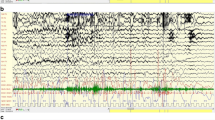Abstract
It has been reported that self-awakening, the ability to awaken without using an alarm at a predetermined time, can reduce sleep inertia immediately after awakening. To clarify the psychophysiological mechanisms underlying this effect, electroencephalogram activity was analyzed for 90 min before awakening on forced- and self-awakening nights for eight participants (21–23 years). The results showed that sigma band power, which reflects sleep spindle activity, gradually decreased during sleep stage 2 before awakening under self-awakening conditions. The previous finding that sleep spindles are involved in the function of maintaining sleep suggests that self-awakening can reduce this function before awakening, thereby attenuating sleep inertia.
Similar content being viewed by others
References
Moorcroft WH, Kayser KH, Griggs AJ. Subjective and objective confirmation of the ability to self-awaken at a self-predetermined time without using external means. Sleep 1997; 20: 40–5.
Jewett ME, Wyatt JK, Ritz-De Cecco A et al. Time course of sleep inertia dissipation in human performance and alertness. J. Sleep Res. 1999; 8: 1–8.
Kaida K, Nittono H, Hayashi M et al. Effects of self-awakening on sleep structure of a daytime short nap and on subsequent arousal levels. Percept. Mot. Skills 2003; 97: 1073–84.
Born J, Hansen K, Marshall L et al. Timing the end of nocturnal sleep. Nature 1999; 397: 29–30.
Kaida K, Ogawa K, Hayashi M et al. Self-awakening prevents acute rise in blood pressure and heart rate at the time of awakening in elderly people. Ind. Health 2005; 43: 179–85.
Kaida K, Nakano E, Nittono H et al. The effects of self-awakening on heart rate activity in a short afternoon nap. Clin. Neurophysiol. 2003; 114: 1896–901.
Tassi P, Bonnefond A, Engasser O et al. EEG spectral power and cognitive performance during sleep inertia: the effect of normal sleep duration and partial sleep deprivation. Physiol. Behav. 2006; 87: 177–84.
Rechtschaffen A, Kales A. A Manual of Standardized Terminology, Techniques and Scoring System for Sleep Stage of Human Subjects. Public Health Service, US Government Printing Office: Washington, DC, 1968.
Ikeda H, Hayashi M. Effects of self-awakening on sleep inertia and on the sleep stages before awakening. Proceeding of the 2nd World Congress of Chronobiology, Tokyo, Japan on 5–6 November, 2007; 101.
Ueda K, Nittono H, Hayashi M et al. Spatiotemporal changes of slow wave activities before and after 14 Hz/12 Hz sleep spindles during stage 2 sleep. Psychiatry Clin. Neurosci. 2001; 55: 183–4.
Author information
Authors and Affiliations
Corresponding author
Rights and permissions
About this article
Cite this article
Ikeda, H., Hayashi, M. Electroencephalogram activity before self-awakening. Sleep Biol. Rhythms 6, 256–259 (2008). https://doi.org/10.1111/j.1479-8425.2008.00366.x
Accepted:
Published:
Issue Date:
DOI: https://doi.org/10.1111/j.1479-8425.2008.00366.x




